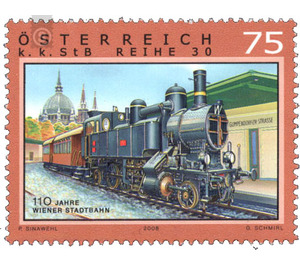railroad - Austria / II. Republic of Austria 2008 - 75 Euro Cent
Theme: Traffic, Transportation & Mobility
| Country | Austria / II. Republic of Austria |
| Issue Date | 2008 |
| Face Value | 75.00 |
| Printing Type | combination printing |
| Stamp Type | Commemorative |
| Item Type | Stamp |
| Chronological Issue Number | 2092 |
| Chronological Chapter | OOS-OE2 |
| SID | 878748 |
| In 60 Wishlists | |
110 years ago, exactly on 9 May 1898, Emperor Franz Josef solemnly opened the Wiener Stadtbahn. Under this name, this public transport existed until 1989. Their routes are now part of the metro network and the Vienna Rapid Transit. Since the first expansion of Vienna in the mid-19th century, plans have been made for a city railway. Decades passed before the first ground-breaking ceremony took place in 1892. The light rail was built as a double track full train. Their purpose was predominantly to connect the many head stations of Vienna among themselves. Technically, the light rail was a mountain railway. The steam locomotives had to cope with a gradient of up to 25 per thousand and the narrowest radii of curvature of 125 meters. The line of 39 km was made under pragmatic aspects along the Wien River and the Danube Canal, along the Linienwalls (Gürtel) and through the suburbs. The order to the commission for traffic systems provided for the establishment of the following lines: the suburban line from Hütteldorf-Hacking over Ottakring to Heiligenstadt, the waist line, the Wiental and Donaukanallinie with a connection from the "main customs office" (now Vienna Mitte) to the North Station (now Praterstern ). As the only means of transport in the world, Wiener Stadtbahn was designed and designed as a unified whole by an architect. It was the k.k. Senior Building Officer Prof. Otto Wagner. In this construction contract he combined art with technology, construction and design in a unique way. Not only station buildings, but also bridges, viaducts and galleries were included in the artwork. Wagner's architectural office designed basic types of station buildings, which were then converted into reality according to local conditions. The pavilions on Karlsplatz and the Hofpavillon in Hietzing are particularly elaborately designed. Otto Wagner's Stadtbahn buildings, executed in Art Nouveau style, are today considered one of the most important works of art in Vienna. As mass transport for the Viennese steam locomotive was little success. Smoke nuisance in the tunnels and hardly possible to change the tram did not make it very user-friendly, and with its own tariff it was also too expensive for the Viennese. In the 1920s, the city of Vienna leased the Gürtel, Wiental and Donaukanallinie and opened it in 1925 as Viennese electric light rail. From 1976, the routes of the electric light rail were gradually taken over in the newly built Vienna subway network. The suburban line as well as the connection from the highway to the Praterstern remained with the Federal Railways and today are part of the rapid transit network.


